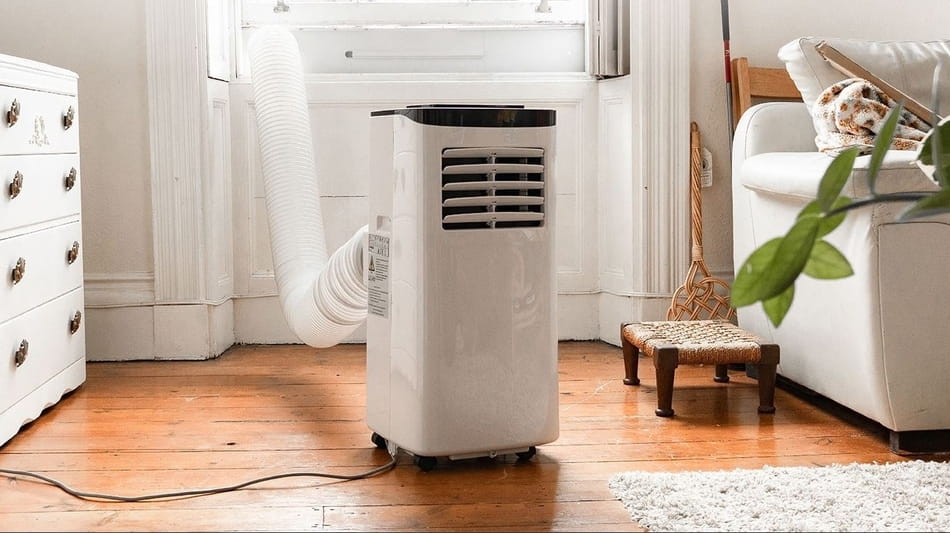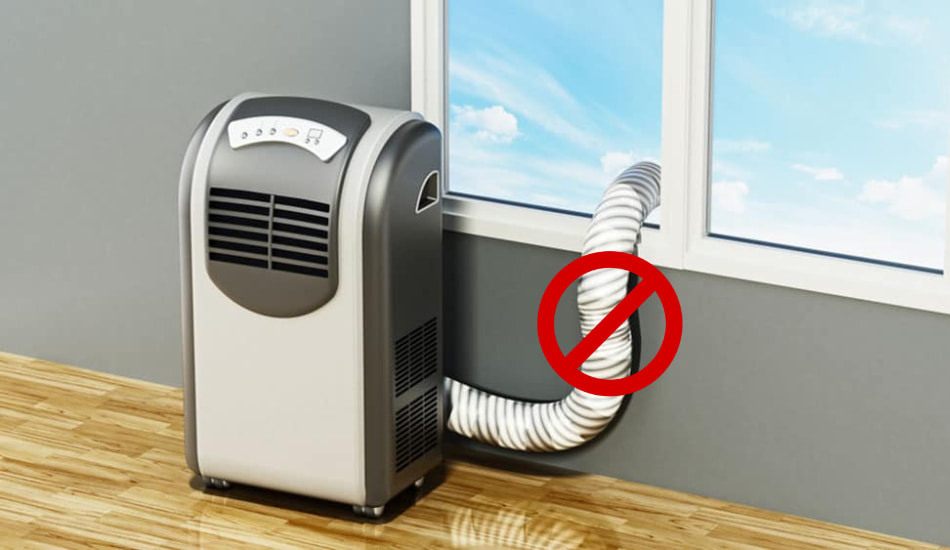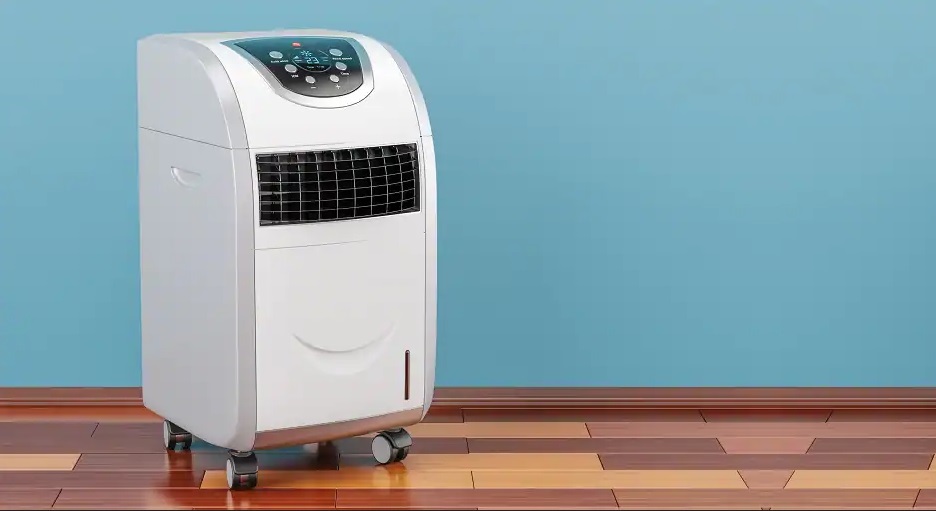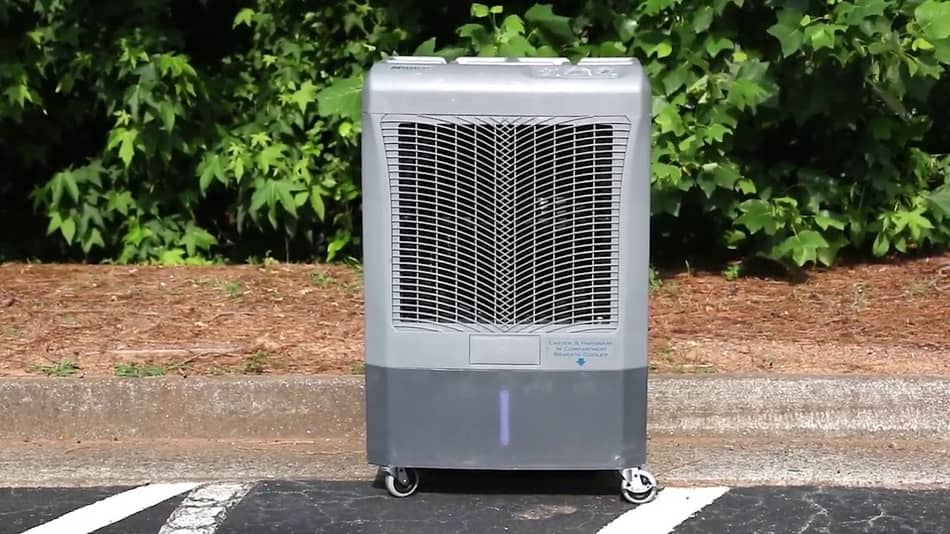Is There A Portable Air Conditioner Without Hose?

Life seems unimaginable without the comfort of air conditioning. These devices undeniably allow us to live more comfortably by maintaining a suitable indoor temperature. The advantage of portable air conditioners has led to the great popularity of these units.
As the name implies, their portability offers the ease of relocating the unit from one space to another, making them a more popular choice over traditional air conditioning systems.
Yet, even these mobile units come with an exhaust vent hose that needs to be placed appropriately. This is why positioning mobile air conditioners near a door or window is necessary.
However, don’t lose hope. Thanks to ongoing innovations and technological progress, it’s now possible to find portable air conditioners that do not require a hose. In this article, we’ll talk about that. So, let’s start!
So, Is It Possible To Use A Portable AC Without Hose? While operating a portable AC without a vent isn’t hazardous, it’s not the most efficient way to use it, and you will not cool the space. You could run a portable AC without an exhaust hose when using it as a dehumidifier. However, remember that this will warm up the room rather than cool it down.
An efficient portable air conditioner system without a hose isn’t possible. The lack of a hose in a portable AC contradicts the Second Law of Thermodynamics. However, there are some alternatives that can be used, such as:
- Ventless Portable Air Conditioners. These portable AC units provide a cooling effect by using evaporation without the necessity for venting. They’re often referred to as ‘evaporative coolers’.
- Other Alternatives For Venting Air Conditioner. Using a window to vent your portable Air conditioner is not always necessary. Although it’s the most popular method. Other methods include using a wall, door, or even dryer vent.
To fully understand why a portable AC without a hose is not possible to have, we will go through that topic in more detail. We’ll also discuss what you can expect when running a portable AC without the hose.
Later, we’ll see the best ways we can get around it – such as ventless AC units and ways to vent portable air conditioners without a window – which can effectively cool your home like a nonexistent hoseless air conditioner would.
Related Article: How To Vent A Dryer In The Middle Of The House
Why Can’t There Be A Portable AC Without A Hose?

Each Air conditioner must have a hose because it’s a critical component of every AC unit. The main role of an AC unit is to cool a particular area. To accomplish this cooling effect, we need to expel the heat from that area (usually to the outside environment).
The exhaust hose enables this heat transfer. To make an area cooler (inside), another area must become warmer (outside). Without a hose, the heat exchange between these two areas becomes impossible.
A portable AC unit without a hose would function in an isolated environment. If no hose facilitates the heat exchange from this area to another, you can’t cool the place.
By understanding this, we can say that using a portable Air conditioner without a hose will likely increase the indoor temperature in the room where you are. Now you know that the hose is an important part that goes with portable air conditioners.
What will happen if you use a portable AC without attaching a hose? Three scenarios can happen:
- Decrease in Temperature. This requires the transfer of heat elsewhere. Heat transfer can’t happen without a hose, making cooling unachievable if you remove the Air conditioner hose.
- Temperature Remains the Same. You might assume that the temperature should stay the same if you have a portable Air conditioner without a hose that you can’t cool. However, this isn’t the case. We’re still operating a device that uses more than 1,000W of power in a closed space. Due to that, heat is produced. Thus, the room’s temperature can’t remain the same with a heat-producing AC with no hose.
- Increase in Temperature. If you disconnect the exhaust hose from a portable air conditioner, the temperature of the closed area (like a room) will go up. The AC itself generates some heat (which is usually negligible if the unit is vented). But without a way for that heat to get out, you’re essentially raising the room’s temperature with a portable air conditioner with a disconnected exhaust hose.
Although this is not the solution we were looking for, there are methods to cool your room without using a hose. In the next section, we’ll talk more about that.
Is it Possible to Use Portable ACs Without A Hose?

If you choose an evaporative cooler, you can utilize portable AC without a hose. However, an evaporative cooler may not be the best solution in areas with high humidity, as it relies on a robust compressor and refrigerant gas to control the indoor temperature.
On the other hand, in regions with lower humidity levels, an evaporative cooler can prove to be quite effective. Since it doesn’t involve any condenser or refrigerant gas, it doesn’t need a hose to expel hot gases. This lets you cool your space without dealing with cumbersome and cluttered air conditioner hoses.
Evaporative Cooler As Alternative AC Without Hose
Evaporative coolers are very simple devices. Their design aims to adjust the environment through the evaporation of moisture.
These units don’t need the extensive refrigeration process that traditional air conditioners require. Yet, much like an AC, you’ll feel a refreshing cool breeze, as it can evaporate moisture within its components and distribute cool air all around.
Typically, an evaporative cooler draws in warm air from its backside using a fan, which is then guided through its internal elements.
A moist, porous membrane inside is used to evaporate the moisture. This process results in refreshing cool breezes from the cooler’s front side. An evaporative cooler serves as the top alternative to Air conditioners that don’t have a hose.

A great way to gain the cooling benefit from an evaporative cooler without raising the room’s temperature is to place the device outside. When placed outdoors, the cooler blows cool air toward us, releasing any heat generated into the open air. It’s no wonder why these swamp coolers are so popular today.
However, if you place them inside, they will be less useful, especially for extended periods. For instance, you can enjoy a refreshing breeze from an evaporative cooler for 1 hour.
However, suppose you let it run for more than 5 hours. In that case, you may notice an increase in the room’s temperature and humidity (evaporative coolers naturally raise humidity levels as a byproduct of water evaporation).
So, evaporative coolers can be considered a ‘type’ of portable AC unit that doesn’t have a hose. While they don’t possess a hose, they aren’t considered air conditioners, making them more suitable for outdoor use.
However, the limitations of evaporative coolers don’t necessarily mean you can’t have an indoor AC unit. As air conditioners without a hose aren’t available, the best solution is to see what is the most effective method to vent a portable AC unit.
If you want to learn more, be sure to watch these 5 Best Portable Air Conditioners Without Hose:
Related Article: How To Quiet A Noisy Air Conditioner? 9 Easy Ways
Must All Portable ACs Vent Via a Window Hose?
Yes, a portable air conditioner requires a hose to vent. There’s no getting around this without violating physics’ fundamental laws. Windows are often the most popular option for venting a portable air conditioner, but there are also other ways to vent. Here are a few different ways to vent a portable AC if you don’t have a window:
- Vent Air Conditioner Through The Ceiling. For those who didn’t know, you can also use the ceiling to vent. In fact, many people wonder if it is possible to use a portable AC unit and vent by using the attic. It’s possible because you reach the attic almost every time you go through the ceiling.
- Venting Via a Wall. If you’re in a room without windows and you need a portable AC, your only choice is to drill a 6″ hole in your wall. This hole can serve as a conduit for the exhaust hose.
- Use a Dryer Vent For Your AC Unit. If a dryer can be vented through a specific vent, you can also use a portable Air conditioner.
- Use Sliding Doors To Vent Via Portable AC. Any door works, but having a sliding door, you can easily fit it with the portable Air Conditioner seal kit.
- Using HVAC Ductwork To Vent. This usually happens when a portable air conditioner needs to supplement central air conditioning. However, this is not so easy to do in some cases. Drilling an additional hole in your ductwork isn’t simple, and you need to consider the additional airflow (CFMs) the ductwork will need to handle.
FAQ: People Also Ask
What is the best air conditioner without a hose?
Our top choice for a portable air conditioner that has no hose is the Honeywell Indoor Portable Air Conditioner. It operates differently from regular portable ACs, which don’t depend on exterior air to chill an area. Instead, this device employs chilled water and ice to generate a refreshing gust of air.
Can I use a portable air conditioner in a room without window access?
Venting a portable air conditioner through the ceiling is also an option if you lack windows. Such ceilings, however, are less common in contemporary homes and are typically found in older residences with high ceilings.
Final Thoughts
In conclusion, portable air conditioners without hoses simply don’t exist. Any real air conditioner must have two parts for heat transfer. A hose is a fundamental part of any AC unit, enabling it to exchange heat. The closest alternative that you can get is evaporative coolers. While they can provide short-term cooling for individuals, they may increase the room’s temperature over time.
Another solution is to install the hose. Some homeowners may feel stuck if they can’t route the hose through a window. However, that’s not the only possibility. You can ventilate a portable Air conditioner using a door, ceiling, or wall. I hope this article has helped you, and if you have any additional questions, feel free to comment.
